Italy
Ivrea
Ivrea, industrial city of the 20th century, was designed as a modern industrial city showing the transition from mechanical to digitalised industrial technologies.
Ivrea was the base of operations for Olivetti, a manufacturer of typewriters, mechanical calculators and, later, computers. Especially Adriano Olivetti in the 1930s developed an interest in architecture and urban planning, and he worked with the best-known Italian architects and town planners of his time. This resulted in industrial and public buildings and a housing plan for workers.
Community Perspective: the state of preservation is far from great and you’ll encounter no-trespassing signs, but there’s a signposted trail with information panels around town. Recently (2023) a new visitor center opened, that has a map of all historic buildings.
Site Info
Official Information
- Full Name
- Ivrea, industrial city of the 20th century (ID: 1538)
- Country
- Italy
- Status
-
Inscribed 2018
Site history
History of Ivrea
- 2018: Advisory Body overruled
- After Referral advice by ICOMOS, amendment lead by Spain
- 2018: Inscribed
- Inscribed
- 2017: Postponed
- 2nd cultural nomination after Venetian Works of Defence in the same year
- Type
- Cultural
- Criteria
- iv
Links
- UNESCO
- whc.unesco.org
- Official
-
- ivreacittaindustriale.it — Candidature website of Ivrea
All Links
UNESCO.org
- whc.unesco.org — whc.unesco.org/
Official Website
- ivreacittaindustriale.it — Candidature website of Ivrea
Community Information
- Community Category
- Urban landscape: Post-medieval European
Travel Information
Piedmont Hotspot
Recent Connections
-
Historic Laboratories
Centro Studi ed Esperienze Olivetti - … -
Piedmont Hotspot
50km / 45min by train -
Built in the 20th century
Mostly 1930s
Connections of Ivrea
- Architecture
-
-
Brick architecture
red brick factory of Camillo Olivetti -
Ideal City
-
Modern Urban Planning
"Designed by leading Italian urban planners and architects, mostly between 1930 and the 1960s .." (description) -
Curtain wall
its 200 m curtain wall is the first example of double glass façade ever realized in Italy.
-
- World Heritage Process
-
-
Inscribed on a single criterion only
Crit IV -
Postponed sites
In 2017, as 2nd cultural nomination after Venetian Works of Defence in the same year -
Minor modifications after inscription
2021: to exclude the site of the recent housing project facing the ‘Red Brick building’ (Fabbrica di Mattoni Rossi) -
2 or more nominated criteria rejected by AB
Rejected: 2, 6. Accepted: 4
-
- Human Activity
- Timeline
-
-
Built in the 20th century
Mostly 1930s
-
- WHS Hotspots
-
-
Piedmont Hotspot
50km / 45min by train
-
- Science and Technology
-
-
Historic Laboratories
Centro Studi ed Esperienze Olivetti - Relevant both to period architecture and "role of Olivetti" which the ensemble represents
-
News
No news.
Recent Visitors
Visitors of Ivrea
- Adrian Turtschi
- Afshin Iranpour
- Alexander Barabanov
- Alexander Lehmann
- alicemears
- Ammon Watkins
- Argo
- Astraftis
- Atila Ege
- BaziFettehenne
- Bill Maurmann
- Bin
- Cezar Grozavu
- Cheryl
- Christoph
- Christravelblog
- Clyde
- Csaba Nováczky
- CugelVance
- Daniel Chazad
- Dan Pettigrew
- David Berlanda
- Dimitar Krastev
- Dwight Zehuan Xiao
- Elia Vettorato
- Elis
- Els Slots
- Farinelli
- Flexiear
- Frederik Dawson
- Harry Mitsidis
- Hasco
- henrik_hannfors
- Hubert
- Iain Jackson
- Ilya Burlak
- Ivan Rucek
- Jakob F.
- Janina Lehmann
- Jan-Willem
- Jarek Pokrzywnicki
- Jawnbeary
- Jean Lecaillon
- Jeanne OGrady
- Jezza
- Joel on the Road
- Jonas Kremer
- KarenBMoore
- Kbecq
- Ken DJ
- Kjsisney
- Knut
- Laurine
- LaVale
- Lisu Marian
- Loic Pedras
- Luboang
- Lucio
- Luis Filipe Gaspar
- Maciej Gil
- Martin
- Martina Rúčková
- Max
- MaYumin
- Mikko
- MoPython
- nan
- Nasebaer
- Nick M
- Patrik
- Peltzi
- Philipp Leu
- Philipp Peterer
- Pieter Dijkshoorn
- Piotr Wasil
- Potsdamer
- Rafał Kałczuga
- Randi Thomsen
- Riccardo Quaranta
- Roger Ourset
- Roman Bruehwiler
- Samy G
- Schnitzel
- Shandos Cleaver
- SirLoydd
- Solivagant
- Stanislaw Warwas
- Stijn
- Svein Elias
- Szucs Tamas
- Taotao Chen
- Tarquinio_Superbo
- Thomas Buechler
- Thomas van der Walt
- Tim Allen
- tommasorossotti
- triath
- Tsunami
- usagi1974
- Vanessa Buechler
- Vincent Cheung
- Walter
- WILLIAM RICH
- Wojciech Fedoruk
- wrung24
- Xiquinho Silva
- Yevhen Ivanovych
- Zach
- Zoë Sheng
Community Reviews
Show full reviews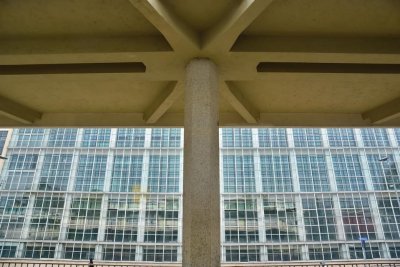
To be honest my main reason to visit Ivrea was its famous chocolate cake, the Torta900 or Torta Novecento at Pasticceria Balla, something that I really wanted to try after seeing the cake on TV couples of years ago, the UNESCO site was just a bonus. Unintentionally the road I used from highway exit to Pasticceria Balla was Via Guglielmo Jervis that run through the core zone of this World Heritage Site. At that time, I had no idea that those buildings were the inscribed ones, I even told my friend that this area must be a new modern zone of Ivrea. After enjoying the very delicious chocolate mousse filling inside cocoa-flavored sponge cake and good Italian coffee, I drove to see Olivetti complex guided by google map to be found out that those modern buildings we saw in the morning was actually our destination.
Fortunately, one free parking lot on Via Guglielmo Jervis was available so we could have a carefree sightseeing. The view of long factory building with many glass windows called ICO Workshop made me think of Van Nelle Factory in my hometown, Rotterdam. To our surprise the whole complex was not a museum, and interior viewing was not allowed, so we had nothing much to do with this beautiful piece of architectural. We impressed with the beautiful hexagonal pillars along the portico of the Social Service Center opposite ICO, the design was really complex but provide lightful environment. Then we went to see the former …
Keep reading 0 comments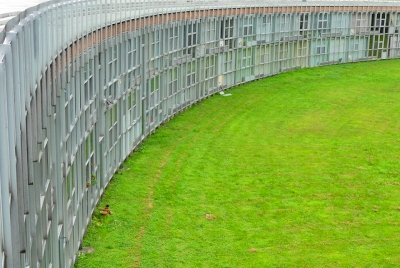
I visited this WHS towards the end of June 2019. Even though I was expecting much from Ivrea, I really wasn't prepared for the appalling state of this newly inscribed WHS.
To me, the only positive aspects of this WHS were the nomination dossier and the informative website and map. However, that's it! What's left of Olivetti's legacy in Ivrea, perfectly illustrated on paper and electronically on the website, definitely doesn't match what I witnessed while visiting the 19 locations of this industrial WHS with 20th century architecture. Most of the locations are in a totally abandoned and neglected state.
The Former Sertec offices (main photo on our site) is now a condemned building with squatters and drug dealers/addicts occupying the building every now and then. Most window panes have been smashed, the interior partition walls have been dismantled, most of the exterior has been vandalised, small trees are growing into the roof and rainwater is slowly destroying the building which has almost no intact windows left. Unfortunately, the same applies to many of the other locations which are not as bad as the former Sertec offices but definitely not in any tip-top condition, let alone exuding any OUV whatsoever.
The only two buildings in Corso Jervis worth mentioning are the glass-paned ICO workshops which are very similar to the architectural style of the Fagus Factory WHS in Germany or the Van Nelle Fabriek in the Netherlands, as well as the Former Olivetti joinery building which is …
Keep reading 0 comments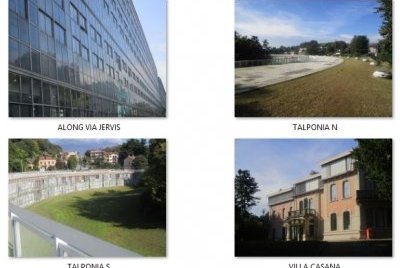
I visited Ivrea from Torino by train on a Sunday morning and spent the first half of my 3 hours there walking around.
There is a map at http://www.ivreacittaindustriale.it/ as well as on sign posts around town. I did not visit all the elements in the map of this industrial city of the last century but tried to see some of the more interesting places.
One of the sign posts pointed to Villa Casana on a hill park in front of Talponia as offering the panoramic view of the town. There are 2 gates to the park, and one of them was slightly open, so I walked in. By the time I go to the Villa I learned at http://www.archiviostoricolivetti.it/ that this villa houses the Olivetti Historical Archive with a permanent exhibition called "One Hundred Years of Olivetti, the Industrial Project." But the Archive was closed on weekend. There was a security guard in a car parked in front of the villa, who asked me how I got in and told me to go back to where I came in from. So I turned back without seeing the panoramic view.
I would say visiting Ivrea on a Sunday morning was good and bad because everything was closed.
I spent the second half of my visit having a piece of dry pizza at the train station and waiting for my train back to Torino.
Keep reading 0 comments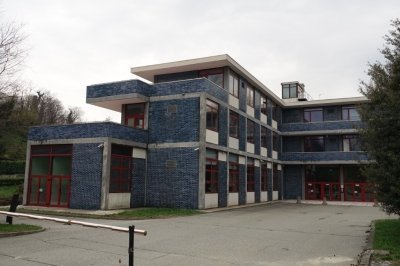
On my last day in Italy I visited Ivrea from Turin. After loads of medieval /Renaissance/Baroque cities and churches taking in some modern architecture was a welcome change.
Ivrea was the location of the headquarters of Olivetti and all the components of the site were Olivetti buildings. While nowadays the fortunes of Olivetti have dwindled, it was a very successful corporation for most parts of the 20th century up to the 80s where Olivetti was the second largest manufacturer of PCs worldwide. Olivetti also created several industrial design classics.
Walking across town I saw multiple factories, office buildings, and residential buildings. These were constructed over the decades while Olivetti kept growing and their styles vary along with the fashions. Also important to note is that the company buildings are just a part of Ivrea. Ivrea is not a fully artificial town as e.g. Crespi d'Adda is. As such, I found myself repeatedly wondering if I was looking at the site or just a normal building. I do recommend downloading the official map from the nomination website before you visit.
The most iconic building is probably the Unitas Residenziale Ovest. The factories are greatly reminiscent of the Van Nelle Factory. And the Centro Studi Ed Esperienza Olivetti offers a colorful Italian touch to modern architecture.
OUV
As pointed out by Els and other reviewers the state of preservation of the site is not great. Many of the buildings show rust and could use fresh paint. The lawns …
Keep reading 0 comments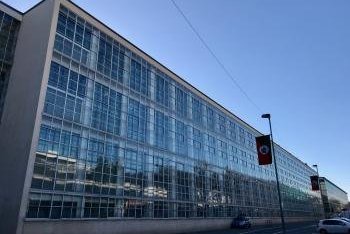
My wife and I visited Ivrea in January 2018 on a sunny winter's afternoon. It's an easy one hour train ride from Turin's two main stations, and trains leave about every hour. The (proposed) World Heritage area is adjacent to the train station, and everywhere is fully walkable.
There's a nice trail of information signs, talking about the Olivetti company and its eponymous founders - the main employers for the town in the 20th century. The large factory building is very impressive and reminded us quite a bit of the Van Nelle factory in Rotterdam.
It seems the town has rebounded a bit since Els's visit, as the main factory building is now occupied by offices for Vodafone Italy, and a few workers were buzzing around (though we visited on a Saturday). The area we walked around did have a lot of closed shops, but it didn't seem particularly grimmer or worse-off than many other areas in Italy.
We were a little disappointed in the crescent-shaped building, as there's not really anything to see since it's built into the side of a hill (and there's large NO TRESPASSING signs). Though I guess all the windows look into the centre of the crescent, and I can imagine the residents don't want visitors peering in!
Overall we enjoyed our visit. We stopped to read all of the information signs, and our visit took about 2 hours all up.
Keep reading 0 comments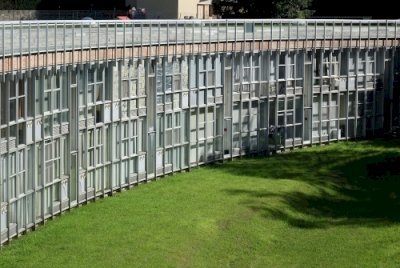
Ivrea, industrial city of the 20th century will be submitted by Italy as their cultural nomination for 2018. It was actually already scheduled for 2017 but had to give way to the Venetian Defence Works. Ivrea lies in the foothills of the Alps, about an hour north of Turin. It’s a sizeable city of 25,000 inhabitants.
Travelling by train from Turin, you’ll surely know when you’ve arrived in Ivrea: the townscape near the train station is invariably modern with lots of apartment blocks. During the 20th century, the city was transformed into the Olivetti Company Town. Olivetti was a very successful producer of typewriters and calculators (until the Age of Computers started). Especially Adriano Olivetti set the most famous Italian architects and planners to work during the period between 1930 and 1960. He promoted a different kind of company town, more geared to the community’s needs (gathered via questionnaires) and involving psychology.
This is going to be a serial nomination consisting of the Via Jervis and the Borgo Olivetti. The Via Jervis is the main drag of the modern city, the Borgo Olivetti comprises six self-sufficient single-family homes nearby. The latter were commissioned by Camillo Olivetti (father of Adriano) in 1926. The local authorities have turned the former company town into an ‘Open Air Museum’: this means that several information panels are strategically placed around town. They also have launched a very informative official website with a good map and detailed descriptions of the individual buildings.
The …
Keep reading 0 comments
